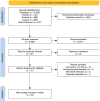Diagnostic value of non-invasive large vessel occlusion detection methods: A systematic review and meta-analysis
- PMID: 40452472
- PMCID: PMC12129949
- DOI: 10.1177/15910199251345631
Diagnostic value of non-invasive large vessel occlusion detection methods: A systematic review and meta-analysis
Abstract
BackgroundAccurate and timely prehospital detection of large vessel occlusion (LVO) is critical for optimizing patient triage and initiating appropriate reperfusion therapies. Recent advances in portable stroke detection technologies, such as electroencephalography (EEG) and transcranial Doppler (TCD) ultrasound, offer potential solutions but their diagnostic performance remains unclear.MethodsWe searched PubMed, Scopus, Embase, and Web of Science, following the PRISMA guidelines. Studies were included if they assessed the diagnostic performance of non-invasive prehospital LVO detection tools compared to CT or MR angiography. Risk of bias was assessed using the QUADAS-2 tool.ResultsA total of 13 studies were included, examining various portable detection tools including EEG or neurophysiological monitoring, ultrasound-based techniques including TCD or TCCD, portable Openwater optical blood flow monitor and cranial accelerometry. The pooled diagnostic odds ratio (DOR) was 52.7 (95% CI: 28.3-97.8), indicating strong diagnostic performance, with significant heterogeneity among studies (I2 = 67.3%, P < 0.001). Subgroup analysis revealed that TCD-based methods had the highest DOR (120.4, 95% CI: 76.9-188.7), followed by other tools (26.8, 95% CI: 13.7-52.6), and EEG (18.2, 95% CI: 9.1-36.3). The pooled sensitivity was 87.4% (95% CI: 82.5-91.0) and specificity was 89.39% (95% CI: 83.0-93.5) across all methods. TCD-based methods showed the highest specificity (95.0%, 95% CI: 91.8-97.0).ConclusionNon-invasive prehospital LVO detection tools show promising diagnostic performance, particularly TCD-based methods. Future studies should focus on validating these tools in larger, diverse populations to enhance prehospital stroke triage and improve patient outcomes.
Keywords: Doppler; Stroke; electroencephalography; emergency medical services; transcranial; triage; ultrasonography.
Conflict of interest statement
The authors declared the following potential conflicts of interest with respect to the research, authorship, and/or publication of this article: RK received research support from NIH, Cerenovus Inc, Medtronic, Endovascular Engineering, Insera Therapeutics, Frontior Bio, Sensome Inc, Endomimetics, Ancure LLC, Neurogami Medical, MIVI Biosciences, Monarch Biosciences, Stryker Inc, Piraeus Medical, MIVI Biosciences and Bionaut Labs.
DFK holds equity in Nested Knowledge, Superior Medical Editors, and Conway Medical, Marblehead Medical and Piraeus Medical. He receives grant support from MicroVention, Medtronic, Balt, and Insera Therapeutics; has served on the Data Safety Monitoring Board for Vesalio; and received royalties from Medtronic.
Figures





Similar articles
-
Transcranial Doppler sonography for detecting stenosis or occlusion of intracranial arteries in people with acute ischaemic stroke.Cochrane Database Syst Rev. 2020 Feb 19;2(2):CD010722. doi: 10.1002/14651858.CD010722.pub2. Cochrane Database Syst Rev. 2020. PMID: 32072609 Free PMC article.
-
Large Vessel Occlusion Stroke Detection in the Prehospital Environment.Curr Emerg Hosp Med Rep. 2021 Sep;9(3):64-72. doi: 10.1007/s40138-021-00234-9. Epub 2021 Jun 28. Curr Emerg Hosp Med Rep. 2021. PMID: 36204242 Free PMC article.
-
Portable cerebral blood flow monitor to detect large vessel occlusion in patients with suspected stroke.J Neurointerv Surg. 2025 Mar 17;17(4):388-393. doi: 10.1136/jnis-2024-021536. J Neurointerv Surg. 2025. PMID: 38514189
-
Detection of Large Vessel Occlusion Stroke in the Prehospital Setting: Electroencephalography as a Potential Triage Instrument.Stroke. 2021 Jul;52(7):e347-e355. doi: 10.1161/STROKEAHA.120.033053. Epub 2021 May 4. Stroke. 2021. PMID: 33940955 Review.
-
Systematic Review and Meta-Analysis of Prehospital Machine Learning Scores as Screening Tools for Early Detection of Large Vessel Occlusion in Patients With Suspected Stroke.J Am Heart Assoc. 2024 Jun 18;13(12):e033298. doi: 10.1161/JAHA.123.033298. Epub 2024 Jun 14. J Am Heart Assoc. 2024. PMID: 38874054 Free PMC article.
References
-
- Benjamin EJ, Muntner P, Alonso A, et al. Heart disease and stroke statistics—2019 update: a report from the American Heart Association. Circulation 2019; 139: e56–e528. - PubMed
-
- Rai AT, Link PS, Domico JR. Updated estimates of large and medium vessel strokes, mechanical thrombectomy trends, and future projections indicate a relative flattening of the growth curve but highlight opportunities for expanding endovascular stroke care. J Neurointerv Surg 2023; 15: e349–ee55. - PMC - PubMed
-
- Levine SR. The time man has cometh to brain: tick… death…. tick… death. Am Heart Assoc 2006; 37: 10. - PubMed
-
- Gorelick PB. The global burden of stroke: persistent and disabling. Lancet Neurol 2019; 18: 417–418. - PubMed
-
- Jazayeri SB, Zamarud A, Derhab M, et al. New insights on the predictive value of hypoperfusion intensity ratio in thrombectomy: an updated systematic review and meta-analysis with multiple cut-offs. J Neurointerv Surg 2025: jnis-2024-023000, 1–11. - PubMed
Publication types
LinkOut - more resources
Full Text Sources

